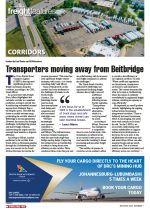The Cross-Border Road Transpor t Agency (C-BRTA) has reported significant growth in freight movement along key corridors, according to its CEO, Lwazi Mboyi.In an interview with Freight News, Mboyi highlighted the Lebombo corridor as a standout performer, noting its pivotal role in redirecting substantial mineral exports from Richards Bay to the Maputo ports. This shift has driven a notable revenue surge, positioning the corridor ahead of Beitbridge in income generation. However, the success has brought challenges, including long queues and heavy freight volumes, underscoring the urgent need for strategic interventions to improve ef f icienc y.According to Mboyi, another performer is the corridor from South Africa to Botswana passing through the Groblersbrug border post, now second on the South African Revenue Service list for revenue processed. “This route has seen significant freight volume increases, with some 1 000 trucks transiting daily,” said Mboyi.Some of the growth on this corridor has been attributed to the challenges of transit on the North-South Corridor. The Beitbridge border post has long been synonymous with delays and congestion and also associated with high costs.“ We have increasingly seen operators transition to Groblersbrug,” said Mboyi. “The infrastructure, however, remains inadequate, with the 1938-built single-lane bridge causing delays. Improving the infrastructure at Groblersbug is critical to bring about more efficiency on the corridor. We’ve conducted three visits this year and are collaborating with local teams and freight companies to address the challenges.”The North-South Corridor, anchored by Beitbridge, has experienced declining freight volumes due to high costs and additional surcharges following recent border upgrades. “Transporters are exploring alternatives, which is a worrying trend,” he noted.According to Mboyi, Botswana has emerged as a competitive force in cross-border trade, with investments in infrastructure at its various border posts and road networks resulting in faster processing and smoother freight movement. “The stability of systems in countries across southern Africa is crucial to the efficiency of our regional corridors,” he said. “When tariffs and regulations are inconsistent, transporters are forced to seek alternative routes. This creates scenarios like what we’ve seen at Groblersbrug, where the system is suddenly overwhelmed by unplanned freight volumes, straining its capacity to cope effectively.”He expressed an overall positive outlook, highlighting the ongoing infrastructure investments along several corridors. “There is definitely increased investment, which is encouraging, but much more work remains to be done,” he said. “At the C-BRTA, we are actively collaborating with various stakeholders to support infrastructure development. A key focus for us in 2025 is the establishment of truck stops and safe areas where drivers can take essential breaks and get much-needed rest. This is a critical priority to enhance both safety and efficiency across our corridors.” LV

